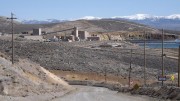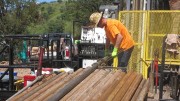Pilot Gold (TSX: PLG) is staking more ground near its Goldstrike project in southwestern Utah near the border with Nevada, and is picking up where the old miners left off.
Between 1988 and 1994, an oxide heap-leach mine on the property churned out 209,000 oz. gold and 197,000 oz. silver from 8 million tonnes ore at an average recovered grade of 1.2 grams gold per tonne from 12 shallow pits. The mine closed due to low gold prices.
In addition to the past-producing mine, the Goldstrike property has an exploration database, shallow drill holes with un-mined oxide gold intercepts and untested gold targets.
The main target is Carlin-style, shallow oxide gold mineralization along a 7 km long and 2 km wide historic mine trend, between and down-dip to the north of historic open pits, about 50 km northwest of St. George.
Pilot Gold’s Main zone has been defined by 700 historic reverse-circulation (RC) drill holes and 10 historic core holes. The company’s own work since 2015 has added another 80 RC holes and 10 core holes.
It took the company nearly 16 months at Goldstrike to work up data, validate it and create a 3-D model before drill-testing.
The additional claims Pilot Gold staked at the project in August cover projected extensions of the mineralized system. The three targets aggregate 8 sq. km and are west, north and east of the historic mine trend.
“We’ve done a good job of assembling our property position, but we just wanted to make sure that we had every possible target covered,” the company’s vice-president of exploration and geoscience Moira Smith says. “They’re really grassroots — we just wanted to secure everything in the district that looks prospective — and we’ve achieved that.”
The ATF Block target adjoins the western property boundary and covers 1.2 km of linear jasperoid exposures in Paleozoic carbonate rocks along strike of the historic mine trend, and has never been drill tested, Smith says.
The Live Oak target is north of the project area and covers a 1.8 sq. km historic gold-in-soil geochemical anomaly. The target includes skarn associated with a faulted margin of an intrusive body. “There was some old drilling there that came up with gold in drill holes that looks promising,” Smith adds.
The Big Mac target is a Goldstrike look-alike target 2 km southeast of the Main project area, with gold in surface samples in the basal Claron Formation.
In addition to news of the staking, the company released results from seven RC drill holes it has drilled into the Main zone. Five of the seven intersected widths grading between 0.67 gram gold per tonne and 1.08 grams gold per tonne.
Highlights included intercepts of 0.43 gram gold per tonne over 10.7 metres and 1.10 grams gold over 3 metres; 1.08 grams gold over 45.7 metres, including 3.06 grams gold over 6.1 metres; and 0.90 gram gold over 18.3 metres, including 1.32 grams gold over 7.6 metres.
The drilling is defining the edges of the main zone on the east end of the historic mine trend for a resource estimate that Pilot Gold hopes to finish in the first quarter of next year.
A total of 15 additional RC drill holes have been planned to fill in the area of the Main zone — which would cover 1,400 by 300 metres of strike on the historic mine trend. Once all of the holes are done, the drill rig will be moved to the Peg Leg Graben — sub-parallel and southwest of the Main zone.
The Peg Leg Graben runs 1.5 km long and up to 250 metres wide and, while surface mineralization on the graben margins has been tested by drilling, the graben itself has only seen three historic drill holes, all of which returned oxide gold intercepts.
The first historic drill hole returned a 0.76 gram gold intercept over 6.1 metres, 0.66 gram gold over 9.1 metres and 1.10 grams gold over 12.2 metres, starting from 61 metres down hole. The second returned 0.67 gram gold over 27.4 metres, starting from 82.3 metres down hole, and the third averaged 0.43 gram gold over 4.6 metres and 0.57 gram gold over 10.7 metres, starting from 18.3 metres down hole.
Pilot Gold plans to build 14 drill sites 80 metres apart along the graben, with up to four holes drilled per site.
“The Peg Leg target is high on our list,” Smith notes.
The company is adding a second drill rig to focus on other targets, including the Dip Slope area, north of the Main zone.
The 2016 infill and step-out drilling program is targeting unmined and undrilled areas between and around the historic pits on the property.
“We’re still looking at 100 or so drill holes before year-end — we’ll drill right to the end of November,” Smith says, adding that the company also expects results from its metallurgical test work.
Pilot Gold acquired 100% of Goldstrike through its August 2014 acquisition of Cadillac Mining.
The company’s other projects in the U.S. include Mineral Gulch in Idaho and Kinsley Mountain in Nevada.
Over the last year Pilot Gold’s shares have traded in a range of 22¢ to 95¢, and at press time traded at 72¢ apiece. The company has 125.8 million shares outstanding for an $89.3-million market capitalization.
Michael Gray of Macquarie has an “outperform” rating on the stock with a 90¢-per-share price target, and says in a research note that the company is one of his top picks amongst the explorers.
“Although there are many other intriguing targets to test in the more than 108 sq. km Goldstrike land package, vice-president of exploration Moira Smith’s confidence in the potential of this underexplored region has encouraged securing claims sooner rather than later.”





Be the first to comment on "Pilot Gold stakes more ground at Goldstrike"